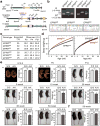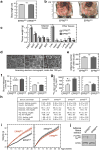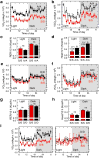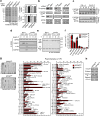EPRS is a critical mTORC1-S6K1 effector that influences adiposity in mice
- PMID: 28178239
- PMCID: PMC5480610
- DOI: 10.1038/nature21380
EPRS is a critical mTORC1-S6K1 effector that influences adiposity in mice
Abstract
Metabolic pathways that contribute to adiposity and ageing are activated by the mammalian target of rapamycin complex 1 (mTORC1) and p70 ribosomal protein S6 kinase 1 (S6K1) axis. However, known mTORC1-S6K1 targets do not account for observed loss-of-function phenotypes, suggesting that there are additional downstream effectors of this pathway. Here we identify glutamyl-prolyl-tRNA synthetase (EPRS) as an mTORC1-S6K1 target that contributes to adiposity and ageing. Phosphorylation of EPRS at Ser999 by mTORC1-S6K1 induces its release from the aminoacyl tRNA multisynthetase complex, which is required for execution of noncanonical functions of EPRS beyond protein synthesis. To investigate the physiological function of EPRS phosphorylation, we generated Eprs knock-in mice bearing phospho-deficient Ser999-to-Ala (S999A) and phospho-mimetic (S999D) mutations. Homozygous S999A mice exhibited low body weight, reduced adipose tissue mass, and increased lifespan, similar to S6K1-deficient mice and mice with adipocyte-specific deficiency of raptor, an mTORC1 constituent. Substitution of the EprsS999D allele in S6K1-deficient mice normalized body mass and adiposity, indicating that EPRS phosphorylation mediates S6K1-dependent metabolic responses. In adipocytes, insulin stimulated S6K1-dependent EPRS phosphorylation and release from the multisynthetase complex. Interaction screening revealed that phospho-EPRS binds SLC27A1 (that is, fatty acid transport protein 1, FATP1), inducing its translocation to the plasma membrane and long-chain fatty acid uptake. Thus, EPRS and FATP1 are terminal mTORC1-S6K1 axis effectors that are critical for metabolic phenotypes.
Conflict of interest statement
The authors declare no competing financial interests.
Figures














Comment in
-
Physiology: An atypical switch for metabolism and ageing.Nature. 2017 Feb 16;542(7641):299-300. doi: 10.1038/nature21500. Epub 2017 Feb 8. Nature. 2017. PMID: 28178230 Free PMC article.
-
Papers of note in Nature542 (7641).Sci Signal. 2017 Feb 21;10(467):eaam9984. doi: 10.1126/scisignal.aam9984. Sci Signal. 2017. PMID: 28223419
-
Unexpected metabolic function of a tRNA synthetase.Cell Cycle. 2017;16(23):2239-2240. doi: 10.1080/15384101.2017.1324127. Epub 2017 Dec 7. Cell Cycle. 2017. PMID: 28777042 Free PMC article. No abstract available.
Similar articles
-
Multisite Phosphorylation of S6K1 Directs a Kinase Phospho-code that Determines Substrate Selection.Mol Cell. 2019 Feb 7;73(3):446-457.e6. doi: 10.1016/j.molcel.2018.11.017. Epub 2019 Jan 3. Mol Cell. 2019. PMID: 30612880 Free PMC article.
-
Activation of mTORC1 is essential for β-adrenergic stimulation of adipose browning.J Clin Invest. 2016 May 2;126(5):1704-16. doi: 10.1172/JCI83532. Epub 2016 Mar 28. J Clin Invest. 2016. PMID: 27018708 Free PMC article.
-
Chronic inhibition of the mTORC1/S6K1 pathway increases insulin-induced PI3K activity but inhibits Akt2 and glucose transport stimulation in 3T3-L1 adipocytes.Mol Endocrinol. 2010 Apr;24(4):766-78. doi: 10.1210/me.2009-0328. Epub 2010 Mar 4. Mol Endocrinol. 2010. PMID: 20203102 Free PMC article.
-
Experimental approaches for investigation of aminoacyl tRNA synthetase phosphorylation.Methods. 2017 Jan 15;113:72-82. doi: 10.1016/j.ymeth.2016.10.004. Epub 2016 Oct 8. Methods. 2017. PMID: 27729295 Free PMC article. Review.
-
Role of mTORC1-S6K1 signaling pathway in regulation of hematopoietic stem cell and acute myeloid leukemia.Exp Hematol. 2017 Jun;50:13-21. doi: 10.1016/j.exphem.2017.02.004. Epub 2017 Mar 22. Exp Hematol. 2017. PMID: 28342808 Free PMC article. Review.
Cited by
-
The central moTOR of metabolism.Dev Cell. 2022 Mar 28;57(6):691-706. doi: 10.1016/j.devcel.2022.02.024. Epub 2022 Mar 21. Dev Cell. 2022. PMID: 35316619 Free PMC article. Review.
-
MicroRNA-506 modulates insulin resistance in human adipocytes by targeting S6K1 and altering the IRS1/PI3K/AKT insulin signaling pathway.J Bioenerg Biomembr. 2021 Dec;53(6):679-692. doi: 10.1007/s10863-021-09923-2. Epub 2021 Oct 31. J Bioenerg Biomembr. 2021. PMID: 34718921 Free PMC article.
-
The Role of Obesity in Breast Cancer Pathogenesis.Cells. 2023 Aug 14;12(16):2061. doi: 10.3390/cells12162061. Cells. 2023. PMID: 37626871 Free PMC article. Review.
-
Metabolic Communication and Healthy Aging: Where Should We Focus Our Energy?Dev Cell. 2020 Jul 20;54(2):196-211. doi: 10.1016/j.devcel.2020.06.011. Epub 2020 Jul 2. Dev Cell. 2020. PMID: 32619405 Free PMC article. Review.
-
Multi-omic stratification of the missense variant cysteinome.bioRxiv [Preprint]. 2023 Aug 14:2023.08.12.553095. doi: 10.1101/2023.08.12.553095. bioRxiv. 2023. Update in: Nat Commun. 2024 Oct 28;15(1):9284. doi: 10.1038/s41467-024-53520-x. PMID: 37645963 Free PMC article. Updated. Preprint.
References
-
- Magnuson B, Ekim B, Fingar DC. Regulation and function of ribosomal protein S6 kinase (S6K) within mTOR signalling networks. Biochem J. 2012;441:1–21. - PubMed
Publication types
MeSH terms
Substances
Grants and funding
LinkOut - more resources
Full Text Sources
Other Literature Sources
Molecular Biology Databases
Research Materials
Miscellaneous

